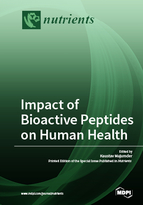Impact of Bioactive Peptides on Human Health
A special issue of Nutrients (ISSN 2072-6643).
Deadline for manuscript submissions: closed (31 August 2018) | Viewed by 88383
Special Issue Editor
Special Issue Information
Dear Colleagues,
Food-derived bioactive peptides are increasingly becoming recognized as major food compounds for human health promotion by preventing the occurrence of chronic diseases through their impacts on the gastrointestinal, cardiovascular, immune, and nervous systems. New discoveries on bioactive peptides are important for the maintaining human health and commercial development of the area of functional foods and/or nutraceuticals. This Special Issue covers a wide range of research topics specifically on food-derived bioactive peptides including the in-vitro and in-vivo evaluation of biological activities, bioaccessibility, intestinal absorption, bioavailability, the effect on chronic diseases, and modulating human nutrition.
Dr. Kaustav MajumderGuest Editor
Manuscript Submission Information
Manuscripts should be submitted online at www.mdpi.com by registering and logging in to this website. Once you are registered, click here to go to the submission form. Manuscripts can be submitted until the deadline. All submissions that pass pre-check are peer-reviewed. Accepted papers will be published continuously in the journal (as soon as accepted) and will be listed together on the special issue website. Research articles, review articles as well as short communications are invited. For planned papers, a title and short abstract (about 100 words) can be sent to the Editorial Office for announcement on this website.
Submitted manuscripts should not have been published previously, nor be under consideration for publication elsewhere (except conference proceedings papers). All manuscripts are thoroughly refereed through a single-blind peer-review process. A guide for authors and other relevant information for submission of manuscripts is available on the Instructions for Authors page. Nutrients is an international peer-reviewed open access semimonthly journal published by MDPI.
Please visit the Instructions for Authors page before submitting a manuscript. The Article Processing Charge (APC) for publication in this open access journal is 2900 CHF (Swiss Francs). Submitted papers should be well formatted and use good English. Authors may use MDPI's English editing service prior to publication or during author revisions.
Keywords
- Bioactive peptides
- Food Proteins
- Functional Foods
- Nutraceuticals







